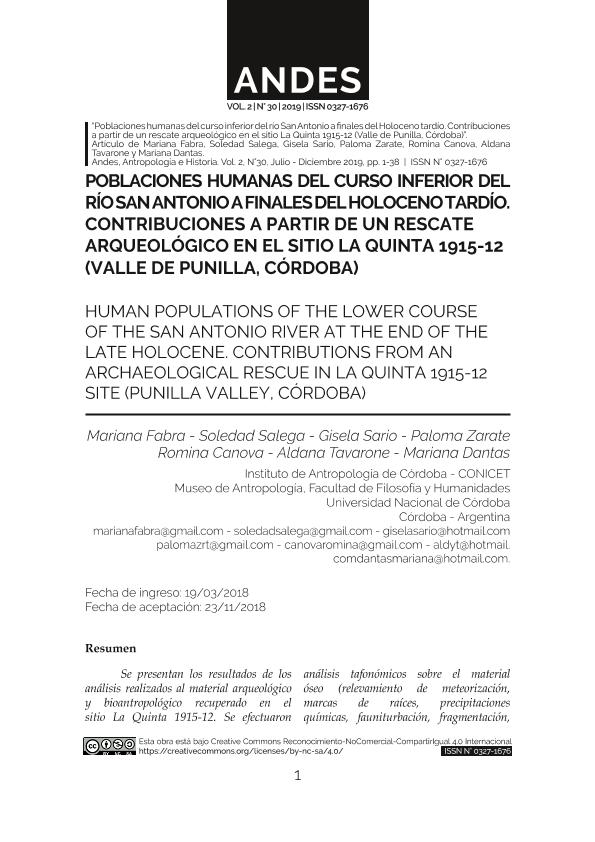Artículo
Se presentan los resultados de los análisis realizados al material arqueológico y bioantropológico recuperado en el sitio La Quinta 1915-12. Se efectuaron análisis tafonómicos sobre el material óseo (relevamiento de meteorización, marcas de raíces, precipitaciones químicas, fauniturbación, fragmentación, modificaciones antrópicas, porcentaje de superficie preservada y grado de integridad), bioantropológicos (MNI, MNE, MAU, MAU%), así como análisis tecnotipológicos sobre el material lítico. Se recuperaron restos óseos humanos de al menos 7 individuos (6 adultos y 1 infante), 308 especímenes faunísticos, identificados como Chinchillidae, Equidae, Bovidae y mamíferos grandes indeterminados y 184 artefactos líticos de cuarzo y rocas silíceas y 4 ecofactos, que por sus características sugieren actividades de talla y procesamiento de materias primas. Se discuten similitudes y diferencias con respecto a otros sitios de la región. Interesa aportar a la discusión acerca de las ocupaciones humanas que habitaron esta región en el Holoceno tardío, particularmente aspectos vinculados a la dieta y salud de las personas que fueron inhumadas en el sitio, la presencia de anomalías congénitas, así como cuestiones relacionadas al uso que hicieron del espacio y los recursos disponibles. The results of the analyses carried out on archaeological and bioanthropological material recovered at La Quinta 1915-12 site are. Taphonomic variables were recorded on the osseous material (weathering, root marks, chemical precipitation, fauniturbation, fragmentation, anthropic modifications, percentage of preserved surface and degree of integrity). Bioanthropological analyses (MNI, MNE, MAU, MAU%), and technotypological analyses on lithic material were also applied. Human skeletal remains of at least 7 individuals (6 adults and 1 infant) were recovered, as well as 308 identified faunal specimens which were identified as Chinchillidae, Equidae and Bovidae and undetermined mammals, 185 quartz and siliceous lithic artifacts and 4 ecofacts (whose characteristics suggest activities of carving and processing of raw materials). Similarities and differences regarding to other sites in the region are discussed. It is interesting to contribute to the discussion about the human settlements that were established in this region during the late Holocene, especifically related to the diet and health of people who were buried in the site, congenital anomalies, as well as issues related to their use of space and available resources.
Poblaciones humanas del curso inferior del río San Antonio a finales del Holoceno tardío. Contribuciones a partir de un rescate arqueológico Sitio La Quinta 1915-12 (valle de Punilla, Córdoba)
Título:
Human populations of the lower course of the San Antonio river at the end of the late Holocene. Contributions from an archaeological rescue in La Quinta 1915-12 Site (Punilla valley, Córdoba)
Fabra, Mariana ; Salega, María Soledad
; Salega, María Soledad ; Sario, Gisela Mariela
; Sario, Gisela Mariela ; Zarate, Paloma; Canova, Romina Andrea; Tavarone, Aldana
; Zarate, Paloma; Canova, Romina Andrea; Tavarone, Aldana ; Dantas, Mariana
; Dantas, Mariana
 ; Salega, María Soledad
; Salega, María Soledad ; Sario, Gisela Mariela
; Sario, Gisela Mariela ; Zarate, Paloma; Canova, Romina Andrea; Tavarone, Aldana
; Zarate, Paloma; Canova, Romina Andrea; Tavarone, Aldana ; Dantas, Mariana
; Dantas, Mariana
Fecha de publicación:
12/2019
Editorial:
Universidad Nacional de Salta. Centro Promocional de las Investigaciones en Historia y Antropología
Revista:
Andes
ISSN:
0327-1676
e-ISSN:
1668-8090
Idioma:
Español
Tipo de recurso:
Artículo publicado
Clasificación temática:
Resumen
Archivos asociados
Licencia
Identificadores
Colecciones
Articulos(IDACOR)
Articulos de INSTITUTO DE ANTROPOLOGIA DE CORDOBA
Articulos de INSTITUTO DE ANTROPOLOGIA DE CORDOBA
Citación
Fabra, Mariana; Salega, María Soledad; Sario, Gisela Mariela; Zarate, Paloma; Canova, Romina Andrea; et al.; Poblaciones humanas del curso inferior del río San Antonio a finales del Holoceno tardío. Contribuciones a partir de un rescate arqueológico Sitio La Quinta 1915-12 (valle de Punilla, Córdoba); Universidad Nacional de Salta. Centro Promocional de las Investigaciones en Historia y Antropología; Andes; 30; 2; 12-2019; 1-38
Compartir



